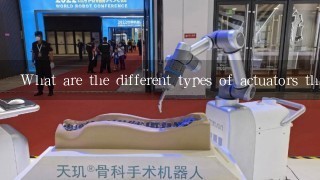What are the different types of actuators that robots use?

Mechanical actuators:
- Motors: Electric motors provide the power to move the robot's limbs and body.
- Gears: Gears allow the robot to change speed and torque.
- Pneumatic actuators: Compressed air is used to operate the robot's joints and actuators.
- Hydraulic actuators: Hydraulic fluid is used to operate the robot's joints and actuators.
Electrical actuators:
- Microcontrollers: Microcontrollers control the robot's movements and behavior.
- Digital signals: Digital signals are used to control the robot's actuators.
- Analog signals: Analog signals are used to control the robot's speed and position.
Other actuators:
- Magnetic actuators: Magnetic fields are used to attract or repel objects.
- Chemical actuators: Chemical reactions are used to control the robot's movements or behavior.
- Light and sound actuators: Light and sound are used to provide visual and auditory feedback to the user.
The choice of actuator depends on a number of factors, including:
- The type of task the robot is designed to perform
- The environment in which the robot will be used
- The budget
- The skill level of the user
Here are some examples of how robots use different types of actuators:
- A surgical robot uses motors and a camera to perform minimally invasive surgery.
- A vacuum cleaner uses a vacuum cleaner motor to pick up dirt and debris.
- A self-driving car uses sensors and a microcontroller to navigate the road.
- A humanoid robot uses a combination of motors, actuators, and sensors to perform tasks such as cooking, cleaning, and playing music.



























































